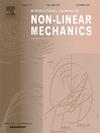具有初始几何缺陷的超材料厚度变形板的自由振动和大变形特性
IF 2.8
3区 工程技术
Q2 MECHANICS
International Journal of Non-Linear Mechanics
Pub Date : 2025-06-26
DOI:10.1016/j.ijnonlinmec.2025.105190
引用次数: 0
摘要
考虑了一种几何不完美的三阶形变超材料厚度和剪切变形板,对其非线性弯曲和自由振动进行了分析。材料的有效性能从板的上表面到板的下表面呈功能梯度分布;通过遗传规划辅助的微观力学模型可以有效地逼近材料的性能。在不忽略几何非线性的前提下,利用Hamilton原理建立了几何不完美三阶形变超材料厚度和剪切变形板的轴向、横向、旋转和拉伸四重耦合非线性运动方程。采用广义微分正交法对运动方程进行离散化;然后求解了非线性弯曲和线性自由振动的离散运动方程。为了进行部分验证,将该模型与公开文献中简化情况(即,不具有超材料特征的单层均匀板)的可用数据以及在ANSYS中建模的单层各向同性矩形完美直板进行了比较。分析了不同几何参数、石墨烯折纸含量、折叠程度、几何缺陷以及石墨烯折纸的对称和非对称分布模式下,超材料系统的复杂非线性力学和线性自由振动。结果表明,几何缺陷减少了横向挠度,具有不对称石墨烯折纸分布的超材料板在所有研究的石墨烯折纸分布中始终具有最大的非线性挠度。本文章由计算机程序翻译,如有差异,请以英文原文为准。
Free vibration and large deformation characteristics of metamaterial thickness-deformable plates with initial geometrical imperfection
A geometrically imperfect third-order auxetic metamaterial thickness- and shear-deformable plate is considered, and both the non-linear bending as well as the free vibrations are analysed. Distribution of the effective material properties from plate’s top surface to the bottom one follows a functionally graded form; material properties are effectively approximated via genetic programming-assisted micromechanics models from previous studies. Without ignoring geometrical non-linearities, the fourfold coupled axial, transverse, rotational, and stretching non-linear motion equations are formulated for a geometrically imperfect third-order auxetic metamaterial thickness- and shear-deformable plate using Hamilton’s principle. The generalised differential quadrature method is implemented to discretise the motion equations; the discretised motion equations are then solved for both the non-linear bending as well as the linear free vibrations. For partial validation, the model is compared with available data from the open literature for simplified cases (i.e., single-layer homogeneous plates without metamaterial characteristics) and with a single-layered isotropic rectangular perfectly straight plate modelled in ANSYS. The complex non-linear mechanics and linear free vibration of the metamaterial system are analysed for different geometrical parameters, graphene origami contents, folding degrees, and geometrical imperfections, and also for both the symmetric and asymmetric distribution patterns of graphene origami. The results reveal that the geometric imperfections reduce the transverse deflection, and metamaterial plates with asymmetric graphene origami distributions consistently have the largest non-linear deflections among all the graphene origami distributions studied.
求助全文
通过发布文献求助,成功后即可免费获取论文全文。
去求助
来源期刊
CiteScore
5.50
自引率
9.40%
发文量
192
审稿时长
67 days
期刊介绍:
The International Journal of Non-Linear Mechanics provides a specific medium for dissemination of high-quality research results in the various areas of theoretical, applied, and experimental mechanics of solids, fluids, structures, and systems where the phenomena are inherently non-linear.
The journal brings together original results in non-linear problems in elasticity, plasticity, dynamics, vibrations, wave-propagation, rheology, fluid-structure interaction systems, stability, biomechanics, micro- and nano-structures, materials, metamaterials, and in other diverse areas.
Papers may be analytical, computational or experimental in nature. Treatments of non-linear differential equations wherein solutions and properties of solutions are emphasized but physical aspects are not adequately relevant, will not be considered for possible publication. Both deterministic and stochastic approaches are fostered. Contributions pertaining to both established and emerging fields are encouraged.

 求助内容:
求助内容: 应助结果提醒方式:
应助结果提醒方式:


